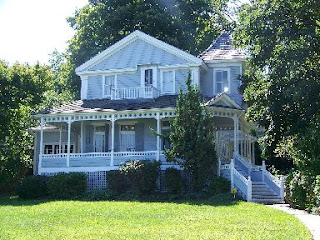Monte Cristo Cottage in New London, Connecticut, piqued my interest last year when I started looking for places to visit with this blog, so my visit (late August) was long overdue. And posting about it even longer obviously. I post it today—October 16—in recognition of Eugene O’Neill’s birthday.
O’Neill was born in 1888 into a dramatic family in every sense of the word. He was the third son of James, a popular actor, and Mary O’Neill. Their first child, Jamie, was born ten years earlier, and a second, Edmund, died at the age of two from measles contracted from his brother. Mary experienced a painful pregnancy with Eugene and developed an addiction to the morphine that she was prescribed.
Monte Cristo, though just a summer cottage, was probably the family’s true home, since James toured with his theatrical company the rest of the year. His family went with him until the boys were old enough for boarding school, so the months in New London were the times the family was together. (The cottage is open to the public through the summer months, the same time the O’Neill family would have occupied it each year.)
Every room, not just the closets, is filled with skeletons. The house itself reflects James: its name celebrates his most famous role, and its elements reveal his personality. The haphazard construction of the second floor addition shows off his penny-pinching ways from the stairway installed in the most economical way that blocks a downstairs window to the cheap wallpaper that adorns the hallway.
One room on the main floor has been furnished according to the set directions in A Long Day’s Journey into Night, O’Neill’s autobiographical drama, which he described as one “of old sorrow, written in tears and blood.” It’s clear reading the scene description that the Tyrone family’s summer home is a re-creation of Monte Cristo:
“At rear are two double doorways with portieres. The one at right leads into a front parlor with the formally arranged, set appearance of a room rarely occupied. The other opens on a dark, windowless back parlor, never used except as a passage from living room to dining room.”
Stepping through the front door to tour the house feels like stepping into the play; the layout is just as O’Neill describes. Wandering back through the living room to the porch (the Long Day’s Journey into Night room) heightens the sensation. It’s just as he describes:
“The hardwood floor is nearly covered by a rug, inoffensive in design and color. At center is a round table with a green shaded reading lamp, the cord plugged into on of the four sockets in the chandelier above. Around the table within reading-light range are four chairs, three of them wicker armchairs, the fourth (at right front of table) a varnished oak rocker with leather bottom.”
There’s the picture of Shakespeare above a bookcase filled with “novels by Balzac, Zola, Stendhal, philosophical and sociological works by Schopenhauer, Nietzsche, Marx, Engels, Kropotkin, Max Stirner, plays by ibsen, Shaw, Strindberg, poetry by Swinburne, Rossetti, Wilde, Ernest Dowson, Kipling, etc.” I can imagine O’Neill eying his own collection as he filled his stage bookshelves with his own books just as he populated the play with his own family.
The room—and even the bookcase—makes an appearance in an earlier play, Ah, Wilderness (1932). This work, which he described in his diary as a “Nostalgic Comedy” is perhaps his imagining a family life in that summer cottage as he wished it could have been. The layout noted in the set directions is slightly different, capturing a lighter mood:
“At center is a big, round table with a green-shaded reading lamp, the cord of the lamp running up to one of five sockets in the chandelier above. Five chairs are grouped about the table—three rockers at left, right, and right rear of it, two armchairs at rear and left rear. A medium-priced inoffensive rug covers most of the floor. The walls are papered with a cheerful, ugly blue design.”
The small bookcase in this house is “crammed with boys’ and girls’ books and the best-selling novels of many past years—books the family really have read.” The current readings of teenaged Richard, “love poetry—and socialism,” haven’t made it onto the shelves; they are the same assortment that O’Neill arranged in the bookcase of Long Day’s Journey, but Richard keeps them hidden from his mother.
Fortunately, nothing is hidden in the cottage nowadays. It is filled with O’Neill memorabilia. Upstairs you can see re-creations of his parents’ bedroom at the back of the house and Eugene’s at the front. Another room (which used to be Jamie’s bedroom) displays costume sketches and set designs from various overseas productions of Anna Christie. Yet another includes examples of O’Neill’s plays translated into a broad variety of languages as well as his Nobel Prize, all testament to the playwright’s international and enduring appeal. Despite all the acclaim, the Nobel Prize–winning, four-time Pulitzer Prize recipient declared that he was most proud of his able seaman’s certification.



No comments:
Post a Comment